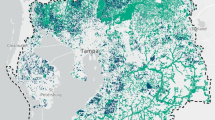Abstract
The extent and causes of changes in the fresh-water wetlands of South Kingstown, Rhode Island were determined through field work and through the analysis of panchromatic aerial photographs taken in 1939 and 1972. During this period, there was a net loss of 0.9 percent of the total area (2345.2 ha) of wetland present in 1939. Highway construction and residential development accounted for most of this loss. Approximately 17 percent of the wetland present in 1939 had changed sufficiently by 1972 to warrant reclassification. Plant succession alone accounted for 57 percent of the changes in wetland types, while man's activities were influential in 41 percent of the cases. Ninety-two percent of the natural changes in wetland types was progressive, while 58 percent of the changes induced by man and undetermined causes was retrogressive. Man's major role was to alter the water regimes and vegetation of wetlands. There was a decrease in wetland diversity as the most abundant type, wooded swamp, grew in area while the abundance of shallow marshes, meadows, and shrub swamps declined. A knowledge of wetland dynamics is essential in the management of wetlands for a diversity of wildlife and other natural values.
Similar content being viewed by others
Literature cited
Carlozzi, C. A. 1971. Enhancement of ecologic and aesthetic values of water associated with interstate highways. Univ. Massachusetts Water Resour. Res. Cent. Publ. 19. 114 pp.
Cunningham, W. T., C. F. Cole, and W. P. MacConnell. 1974. Classification and recent changes (1951–1971) in the tidal wetlands of southeastern Massachusetts. Trans. Northeast Fish Wildl. Conf. 31:205–215.
Daubenmire, R. 1968. Plant communities: a textbook of plant synecology. Harper and Row, New York. 300 pp.
Golet, F. C. 1978. Rating the wildlife value of northeastern fresh water wetlands. Pages 63–73in Wetland functions and values: the state of our understanding. P. E. Greeson, J. R. Clark, and J. E. Clark, eds. Am. Water Resour. Assn., Minneapolis.
Golet, F. C., and J. S. Larson. 1974. Classification of freshwater wetlands in the glaciated northeast. U.S. Fish Wildl. Serv. Resour. Publ. 116. 56 pp.
Goodwin, R. H., and W. A. Niering. 1974. Inland wetlands: their ecological role and environmental status. Bull. Ecol. Soc. 55(2):2–6.
Grace, J. R. 1972. Vegetation and management of wetland forests of northeastern Connecticut. Forest Unit Publ., Connecticut Dept. Envir. Prot. 42 pp.
Green, W. E., L. G. MacNamara, and F. M. Uhler. 1964. Water off and on. Pages 557–568in Waterfowl tomorrow. J. P. Linduska, ed. U.S. Fish Wildl. Serv.
Haramis, G. M. 1975. Wood duck (Aix sponsa) ecology and management within the green-timber impoundments at Montezuma National Wildlife Refuge. M.S. thesis, Cornell Univ. 153 pp.
Heusmann, H. W. 1970. Highway impoundents—planning, use and control. Massachusetts Heritage 8(1): 1–4.
Hodgdon, K. W., and J. H. Hunt. 1966. Beaver management in Maine. Maine Dept. Inland Fisheries and Game, Game Div. Bull. 3. 102 pp.
Kaye, C. A. 1960. Surficial geology of the Kingston quadrangle. U.S. Geol. Surv. Bull. 1071-I. 55 pp.
Larson, J. S. (ed.) 1976. Models for assessment of freshwater wetlands. Univ. Massachusetts Water Resour. Res. Cent. Publ. 32.91 pp.
MacConnell, W. P. 1974. Remote sensing land use and vegetative cover in Rhode Island. Univ. Rhode Island Coop. Ext. Serv. Bull. 200. 93 pp.
Massachusetts Department of Natural Resources. 1967. Report of the Department of Natural Resources relative to the inland wetlands and flood plains of the Commonwealth of Massachusetts with respect to their location, ownership and value for the purpose of recreation, wildlife and conservation of natural resources and any other related matters. Commonwealth of Massachusetts Senate Rept. No. 1273. 23 pp.
Mueller, A. J. 1974. Twenty years of change in open freshwater wetlands on the Massachusetts coastal plain. M.S. thesis, Univ. Massachusetts. 64 pp.
Office of River Basin Studies. 1959. A supplementary report on the wetlands of Rhode Island. U.S. Fish Wildl. Serv., Boston, Mass. Mimeogr. 5 pp.
Parkhurst, J. A. 1977. Freshwater wetland dynamics and related impacts on wildlife in South Kingstown, Rhode Island, 1939–1972. M.S. thesis, Univ. Rhode Island. 104 pp.
Rutherford, W. H. 1964. The beaver in Colorado: its biology, ecology, management and economics. Colorado Game, Fish and Parks Dept. Tech. Bull. 17.49 pp.
Shaw, S. P., and G. C. Fredine. 1956. Wetlands of the United States. U.S. Fish Wildl. Serv. Circ. 39. 67 pp.
Smardon, R. C., and J. Gy. Fabos. 1976. Visual-cultural sub-model. Pages 35–51in Models for assessment of freshwater wetlands. J. S. Larson, ed. Univ. Massachusetts Water Resour. Res. Cent. Publ. 32.
Swank, W. C. 1949. Beaver ecology and management in West Virginia. West Virginia Conserv. Comm., Charleston, W. Va. 65 pp.
Thompson, D. Q., P. B. Reed, Jr., G. E. Cummings, and E. Kivisalu. 1968. Muck hardwoods as green-timber impoundments for waterfowl. Trans. N. Am. Wildl. Nat. Resour. Conf. 33:142–159.
U.S. Bureau of the Census. 1973. 1970 census of population. Vol. 1, Characteristics of the population. Part 41, Rhode Island. U.S. Dept. Commerce. 617 pp.
Wallace, N. 1972. Dredging and filling in coastal New England states under the Federal Permit System, 1966–1971. Trans. Northeast Fish Wildl. Conf. 29:179–185.
Weller, M. W. 1978. Management of freshwater marshes for wildlife. Pages 267–284in Freshwater wetlands: ecological processes and management potential. R. E. Good, D. F. Whigham, and R. L. Simpson, eds. Academic Press, New York.
Author information
Authors and Affiliations
Rights and permissions
About this article
Cite this article
Golet, F.C., Parkhurst, J.A. Freshwater Wetland dynamics in South Kingstown, Rhode Island, 1939–1972. Environmental Management 5, 245–251 (1981). https://doi.org/10.1007/BF01873283
Issue Date:
DOI: https://doi.org/10.1007/BF01873283




